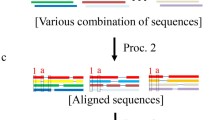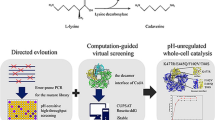Abstract
Directed evolution is a common tool employed to generate enzymes suitable for industrial use. High thermal stability is often advantageous or even a requirement for biocatalysts, as such the evolution of protein stability is of practical as well as academic interest. Even when evolving enzymes for new or improved catalytic functions, stability is an important factor since it can limit the accumulation rate and number of desired active site mutations. Dienelactone hydrolase, a small monomeric protein, has been previously evolved via a three-stage process to possess enhanced activity and specificity toward non-physiological substrates. In addition to seven active site mutations there were three surface mutations that were thought to increase the stability of the enzyme and compensate for the destabilizing active site mutations. Here, the individual influence of the three surface mutations—Q110L, Y137C and N154D—on the thermal and chemical stability of DLH has been assessed. While the Q110L and N154D mutations improved the thermal stability, the influence of the Y137C mutation was more complex. Individually it was destabilizing both thermally and chemically, but when in the presence of the Q110L and N154D mutations its effect was neutralized in relation to thermal but not chemical stability. In the context of a directed evolution experiment, these compensatory surface mutations play important roles. However, our results show that detrimental mutations can arise, thus the simultaneous monitoring of stability changes while evolving enzymes for enhanced catalytic properties can be beneficial.




Similar content being viewed by others
Abbreviations
- DLH:
-
Dienelactone hydrolase
- PCR:
-
Polymerase chain reaction
- SDS-PAGE:
-
Sodium dodecyl sulfate polyacrylamide gel electrophoresis
- Tm :
-
Melting temperature
References
Polizzi KM, Bommarius AS, Broering JM, Chaparro-Riggers JF (2007) Stability of biocatalysts. Curr Opin Chem Biol 11:220–225
Bornscheuer UT, Huisman GW, Kazlauskas RJ, Lutz S, Moore JC, Robins K (2012) Engineering the third wave of biocatalysis. Nature 485:185–194
Turner NJ (2009) Directed evolution drives the next generation of biocatalysts. Nat Chem Biol 5:567–573
Reetz MT (2011) Laboratory evolution of stereoselective enzymes: a prolific source of catalysts for asymmetric reactions. Angew Chem Int Ed 50:138–174
Wang M, Si T, Zhao H (2012) Biocatalyst development by directed evolution. Bioresour Technol 115:117–125
Tracewell CA, Arnold FH (2009) Directed enzyme evolution: climbing fitness peaks one amino acid at a time. Curr Opin Chem Biol 13:3–9
Bloom JD, Meyer MM, Meinhold P, Otey CR, MacMillan D, Arnold FH (2005) Evolving strategies for enzyme engineering. Curr Opin Struct Biol 15:447–452
Bloom JD, Labthavikul ST, Otey CR, Arnold FH (2006) Protein stability promotes evolvability. Proc Natl Acad Sci USA 103:5869–5874
Tokuriki N, Tawfik DS (2009) Stability effects of mutations and protein evolvability. Curr Opin Struct Biol 19:596–604
Pathak D, Ollis D (1990) Refined structure of dienelactone hydrolase at 1.8 Å. J Mol Biol 214:497–525
Porter JL, Carr PD, Collyer CA, Ollis DL (2014) Crystallization of dienelactone hydrolase in two space groups: structural changes caused by crystal packing. Acta Crystallogr Sect F: Struct Biol Cryst Commun 70:884–889
Porter JL, Boon PLS, Murray TP, Huber T, Collyer CA, Ollis DL (2014) Directed evolution of new and improved enzyme functions using an evolutionary intermediate and multidirectional search. ACS Chem Biol. doi:10.1021/cb500809f
Liu J-W, Boucher Y, Stokes HW, Ollis DL (2006) Improving protein solubility: the use of the Escherichia coli dihydrofolate reductase gene as a fusion reporter. Protein Expr Purif 47:258–263
Gasteiger E, Hoogland C, Gattiker A, Se D, Wilkins M, Appel R, Bairoch A (2005) Protein identification and analysis tools on the ExPASy server. In: Walker J (ed) The proteomics protocols handbook. Humana Press, New York, pp 571–607
Krissinel E, Henrick K (2004) Secondary-structure matching (SSM), a new tool for fast protein structure alignment in three dimensions. Acta Crystallogr Sect D: Biol Crystallogr 60:2256–2268
Winn MD, Ballard CC, Cowtan KD, Dodson EJ, Emsley P, Evans PR, Keegan RM, Krissinel EB, Leslie AGW, McCoy A, McNicholas SJ, Murshudov GN, Pannu NS, Potterton EA, Powell HR, Read RJ, Vagin A, Wilson KS (2011) Overview of the CCP4 suite and current developments. Acta Crystallogr Sect D: Biol Crystallogr 67:235–242
Johnson KA, Goody RS (2011) The original Michaelis constant: translation of the 1913 Michaelis–Menten paper. Biochemistry 50:8264–8269
Niesen FH, Berglund H, Vedadi M (2007) The use of differential scanning fluorimetry to detect ligand interactions that promote protein stability. Nat Protoc 2:2212–2221
Levisson M, Oost J, Kengen SWM (2009) Carboxylic ester hydrolases from hyperthermophiles. Extremophiles 13:567–581
Unsworth LD, van der Oost J, Koutsopoulos S (2007) Hyperthermophilic enzymes—stability, activity and implementation strategies for high temperature applications. FEBS J 274:4044–4056
Vieille C, Zeikus GJ (2001) Hyperthermophilic enzymes: sources, uses, and molecular mechanisms for thermostability. Microbiol Mol Biol Rev 65:1–43
Richardson JS (1981) The anatomy and taxonomy of protein structure. Adv Protein Chem 34:167–339
Barlow DJ, Thornton JM (1988) Helix geometry in proteins. J Mol Biol 201:601–619
Stevenson BJ, Liu J-W, Ollis DL (2008) Directed evolution of yeast pyruvate decarboxylase 1 for attenuated regulation and increased stability. Biochemistry 47:3013–3025
Rossky PJ (2008) Protein denaturation by urea: slash and bond. Proc Natl Acad Sci USA 105:16825–16826
Bennion BJ, Daggett V (2003) The molecular basis for the chemical denaturation of proteins by urea. Proc Natl Acad Sci USA 100:5142–5147
Hua L, Zhou R, Thirumalai D, Berne BJ (2008) Urea denaturation by stronger dispersion interactions with proteins than water implies a 2-stage unfolding. Proc Natl Acad Sci USA 105:16928–16933
Canchi DR, Paschek D, Garcia AE (2010) Equilibrium study of protein denaturation by urea. J Am Chem Soc 132:2338–2344
Moeser B, Horinek D (2014) Unified description of urea denaturation: backbone and side chains contribute equally in the transfer model. J Phys Chem B 118:107–114
Ramprakash J, Doseeva V, Galkin A, Krajewski W, Muthukumar L, Pullalarevu S, Demirkan E, Herzberg O, Moult J, Schwarz FP (2008) Comparison of the chemical and thermal denaturation of proteins by a two-state transition model. Anal Biochem 374:221–230
Cowan DA (1997) Thermophilic proteins: stability and function in aqueous and organic solvents. Comp Biochem Physiol Part A: Mol Integr Physiol 118A:429–438
Doukyu N, Ogino H (2010) Organic solvent-tolerant enzymes. Biochem Eng J 48:270–282
Acknowledgments
JLP is supported by an Australian Postgraduate Award from the Australian government and funding from the Research School of Chemistry, ANU. We thank the staff at the ACRF-BRF for performing the DNA sequencing analysis. We also thank Anithahini Jeyasingham from the Mass Spectrometry Department in the Research School of Chemistry at the ANU for conducting the mass spectrometry.
Author information
Authors and Affiliations
Corresponding author
Electronic supplementary material
Below is the link to the electronic supplementary material.
Rights and permissions
About this article
Cite this article
Porter, J.L., Collyer, C.A. & Ollis, D.L. Compensatory Stabilizing Role of Surface Mutations During the Directed Evolution of Dienelactone Hydrolase for Enhanced Activity. Protein J 34, 82–89 (2015). https://doi.org/10.1007/s10930-015-9600-7
Published:
Issue Date:
DOI: https://doi.org/10.1007/s10930-015-9600-7




